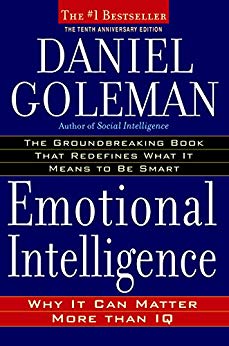

This article is an excerpt from the Shortform summary of "Emotional Intelligence" by Daniel Goleman. Shortform has the world's best summaries of books you should be reading.
Like this article? Sign up for a free trial here .
How do you teach emotional intelligence and literacy to kids? Learn the key principles of teaching kids EQ, empathy, and how to handle their emotions.
In 1990, the US experienced the highest rates it had ever seen of juvenile arrests for violent crimes, teen arrests for rape, teen murder rates, suicide rates, and murder victims under the age of 14. Children at the time were also reported as doing worse in school, socialization, and mood. Wealth made no difference, and neither did ethnicity or race–the problems were universal.
Internationally, families are plagued by financial worries and other stresses, meaning parents can’t spend as much time with their children to teach them emotional intelligence. The need to make money has also increased mobility–people move to where jobs are–so kids have less connection to their extended family, another source of learning.
Since family life doesn’t necessarily offer the same connections and instruction it once did, schools have become the one place communities can depend on to educate their children and correct their behaviors. It’s the one place most children go, and it presents a big opportunity to positively impact upcoming generations.
Emotional literacy is a bigger challenge facing today’s students than any low scores in math or reading, and yet most schools do nothing about this incredibly important subject. Not only that, but emotional distress has significant negative effects on performance–so schools looking to get better academic performance from their students should think about introducing emotional intelligence education.
Emotional Issues in the Classroom
Kids are building differently fundamental skills at different ages, and at different ages, schools and teachers can help them improve critical life skills:
- Preschoolers are building foundational skills, and teaching basic impulse control, self-soothing, and positive communication could go a long way down the line.
- Kindergarteners are entering their first real social world, and starting to feel the “comparison” emotions that come with it: insecurity, jealousy, pride, confidence, or humiliation.
- Late elementary school is when academic performance begins to solidify how a child thinks of herself–as successful, or capable, or stupid, or wrong–and allowing negative self-image to creep in here almost guarantees a diminishment of prospects later in life.
- In middle school or junior high, all students experience a significant decrease in self-confidence and increase in self-consciousness. Self-esteem becomes a major issue.
Children who are angry, depressed, anxious, timid or shy, or socially awkward in particular are at risk of dropping out of school: social rejects will find it more difficult to complete schooling at any level.
- Social rejects essentially have no one to turn to at school, and yet they spend most of their time there. This is incredibly isolating, and reinforces most of their toxic thoughts and bad habits, which in turn negatively affect their academic performance.
Anxiety in the Classroom
High anxiety is almost a guarantee that someone will perform poorly under pressure. Many difficult things children face–poverty, abuse, social rejection, racism, sexism, ableism–cause high levels of anxiety, though these factors may not be easily identifiable by teachers.
Even when someone has a higher IQ, if they also have higher levels of anxiety, they’ll be less likely to fail a test of any kind and perform worse in academic environments.
- 126 separate studies with more than 36,000 participants found that the more a person worries, the more likely they are to perform poorly in academics by any measurable standard, be it test grades, GPAs, or achievement tests.
Anxiety generally circles around self-defeating thoughts that turn into absolutes–”I’ll never be able to do this, I’m not good at this kind of thing”–and this kind of thinking also turns into self-fulfilling prophecies, and ultimately undermines someone’s ability to make decisions with confidence.
Not all anxiety is bad–it’s how we deal with anxiety that determines whether we succeed. Some students crumble under anxiety and perform poorly; some students let their anxiety motivate them to prepare for the challenge, try their hardest, and ultimately succeed.
There’s an ideal peak of useful anxiety in which the amount of nervousness propels the worrier towards excellence. Too little anxiety and someone will feel unmotivated or apathetic about the task at hand; too much anxiety and the person will feel overwhelmed by the pressure and the potential for failure.
- This ideal peak can be referred to as something like hypomania, in which the mind is agitated but in a positive way. Hypomania is thought to be the optimal mindset for some callings, like creative professions, because it energizes the creator and gets them thinking outside the box. But left unchecked the hypomania can devolve into straight mania, and undermine their ability to focus and be coherent.
Good moods and positive feelings enhance our ability to be creative, complex, and flexible, three necessary components for problem-solving.
- If a student is struggling with a problem, try making them laugh. Laughter helps us think broadly and more laterally, associate more freely, and notice relationships we didn’t see before (surprising relationships are the root of all humor).
What School Can Do for Emotional Intelligence
It’s never too early to start introducing emotional intelligence into the learning environment.
In experiments, researchers put emotional intelligence programming into place in schools. Kids and classes who went through emotional intelligence training saw the following benefits:
- They were more responsible, assertive, confident, social, outgoing, helpful, understanding, considerate, concerned, and democratic.
- They had better conflict resolution-skills, coping skills, social cognitive skills, self-control, planning, and focus.
- They improved their ability to recognize and label their own emotions and others’, and experienced less sadness, depression, anxiety, and withdrawal.
- They scored better on standardized achievement tests, and improved their learning-to-learn skills.
- Boys were less aggressive, girls were less self-destructive.
- There were fewer suspensions and expulsions, and less delinquency, drugs, and socially disordered behavior.
- There was a more positive classroom atmosphere, and students had more positive attachment to both school and their families.
Adding Emotional Intelligence to Curriculum
Teachers are already burdened by state-sanctioned requirements, curriculum, and testing material, and it might seem overwhelming to have to introduce emotional intelligence components into totally separate courses.
The good news is that emotional intelligence lessons can be easily integrated into existing subjects, and can be taught alongside already present curriculum.
- For example, you might think math has little to do with emotional intelligence. But math requires studying, and good study habits require some emotional intelligence: the ability to motivate yourself to do something you don’t necessarily want to do, the ability to ignore distractions in favor of a bigger goal, and the ability to manage your impulses to focus on learning. A math class that could incorporate these lessons into the math lessons would most likely see an improvement in test scores.
- Or reading a story about friendship in an English class, and using it as a platform for teaching self-awareness, empathy, and communicating feelings.
———End of Preview———

Like what you just read? Read the rest of the world's best summary of Daniel Coleman's "Emotional Intelligence: Why It Can Matter More than IQ" at Shortform . Learn the book's critical concepts in 20 minutes or less .
Here's what you'll find in our full Emotional Intelligence summary :
- What are emotions? Why do we have them?
- What is emotional intelligence? Why is it important?
- How do you manage your own emotions? Anger, anxiety, and sadness?
- How can you approach your relationships with more emotional intelligence?
- How can you teach your children emotional intelligence?
- How can emotional intelligence boost your career?






